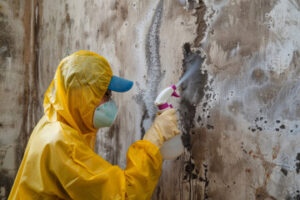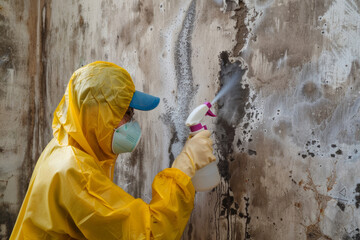Mold Remediation Provo is a process of identifying, containing, removing, and cleaning up any unwanted mold growth. This is important because some varieties of mold are toxic and some can cause severe respiratory problems.
 Visible surface mold on non-porous materials can be cleaned relatively easily. Larger infestations, especially those found in ductwork and HVAC systems, require professional attention.
Visible surface mold on non-porous materials can be cleaned relatively easily. Larger infestations, especially those found in ductwork and HVAC systems, require professional attention.
Mold inspections and remediation are key steps in protecting your home or business from the damage caused by fungi. Professionals use visual inspections to identify the extent of mold contamination, as well as find and repair moisture sources that contribute to future growth. This ensures that all affected areas are addressed and prevents incomplete remediation, which can lead to re-infestation. In addition, regular inspections can catch small mold colonies before they become a problem and prevent the spread of mold spores to new areas.
Symptoms of a mold infestation include a musty odor, visible and non-visible mold, and water or moisture damage. If you notice any of these signs in your building, it is important to take action right away. Mold can cause a variety of health problems, including respiratory symptoms like runny noses and itchy eyes, as well as skin irritations. If you or your family suffer from a chronic illness or have weakened immune systems, exposure to mold can lead to more serious problems.
To test the air quality of a room, technicians use air sampling to measure the concentration of mold spores in the environment. This method can also detect hidden mold colonies that may not be visible on surfaces. Depending on the results of the tests, a detailed mold remediation plan can be developed.
For contaminated materials, such as drywall and insulation, removal and replacement is recommended to avoid further mold growth and deterioration. Infected materials should be removed from the site and disposed of safely to prevent contamination of other areas of the building.
Level IV remediation involves the use of a decontamination room to protect workers and building occupants from harmful mold spores. Workers must wear full-face respirators with HEPA filters and use a special HEPA vacuum to clean the decontamination room before and after entering the work area. They should also wear disposable protective clothing and use a disinfectant to clean their hands. In addition, they should remove individuals with a chronic illness or weakened immune system from adjacent areas to minimize their exposure.
In addition, a specialized fungicide treatment can be used to kill any remaining spores. This treatment does not remove the musty odor, but it can prevent further re-growth and reduce fungicidal costs.
Containment
Mold spores can easily become airborne, traveling to other areas of the building and contaminating them. As such, it is important that any mold remediation efforts take place in a containment site. This will prevent the movement of spores from one area to another and will minimize exposure to the residents or workers in the building. Exposure to large amounts of spores can cause allergy-like symptoms such as runny nose, watery eyes, fatigue and difficulty breathing, and some mold species even produce harmful mycotoxins that can lead to serious illness.
During the containment process, the professionals will use a variety of methods to isolate the work area. These include the installation of plastic containment barriers that are affixed to walls and floors with tape or staples for small jobs and connected to a frame for larger jobs. Fans are then used to create negative air pressure in the contained area, exhausting contaminated air to the outside. This method keeps spores from moving to other parts of the building during the removal and cleaning process.
Additionally, an airlock or decontamination chamber should be set up near the entrance to and exit from the contaminated area. This will separate the clean work area from the contaminated area. The professionals should wear disposable personal protective equipment (PPE) when entering and leaving the containment area to prevent the movement of spores from their bodies to other areas of the building. The professionals should also put on gloves that extend past the middle of their forearm and wear face masks to ensure they are not inhaling any mold spores while working inside the containment area.
Once the containment is complete, the professionals can begin their mold removal and restoration efforts. This may involve removing and disposing of materials like drywall, insulation, flooring and wood that have been affected by the mold. It will also involve using specialized cleaning agents to disinfect and decontaminate the areas that have been impacted by the mold growth. It will also include drying and dehumidifying the area to remove excess moisture that can promote future mold growth.
Cleaning
When fungi grow on porous materials such as drywall, wallpaper, fabric, and carpet, they must be removed, cleaned, and disinfected. Using antifungal and antibacterial cleaners will prevent mold spores from growing in the future. Non-porous surfaces like countertops, sinks, and bathtubs can be scrubbed or wiped clean. Mold in confined spaces such as crawlspaces and pipe chases may require specialized cleaning techniques and equipment. Before entering these areas, workers should wear a respirator and perform oxygen testing to ensure an adequate supply of fresh air.
During mold remediation, workers should also take precautions to protect themselves from cross-contamination. Contaminated clothing and supplies should be placed in sealed bags, and workers should use personal protective equipment (PPE) when handling contaminated materials. They should also use a dust suppression method to minimize the spread of spores during the cleanup process.
After the cleanup process is complete, a final inspection will be conducted to determine whether the area is safe for reoccupation. Mold spores can still be present in the air even after a thorough cleanup, and this can cause health problems for some people. People with allergies, asthma, or weakened immune systems are especially at risk for health problems caused by long-term exposure to mold.
Moisture is the primary driver of mold growth, so it’s important to make sure that the environment in your home is dry and well-ventilated. You can prevent mold growth by keeping humidity levels below 50%, repairing leaky pipes or roofs, and cleaning up any damp areas promptly. Investing in a hygrometer can help you monitor indoor humidity levels regularly.
If you have a large area of mold growth or are concerned about the health effects of mold, it’s best to call in a professional for remediation. They’ll have the equipment and expertise to handle the job safely and effectively. They’ll be able to assess the extent of the problem, identify the type of mold, and determine the source of moisture.
For small infestations, you can try DIY mold removal. Mixing baking soda with water will create a natural fungicide that you can spray onto the affected areas. Let it sit for a few minutes, scrub, and rinse. For particularly tough spots, you can also use a mixture of vinegar and tea tree oil.
Dehumidification
Mold growth is often a result of moisture intrusion and requires constant exposure to water in order to grow. This fungus can be found in and on building materials, and it can be destructive, eroding the structural integrity of structures. It also poses health risks, with certain species causing allergy symptoms and respiratory problems. The best way to keep mold out of your home or business is to prevent it from growing in the first place, and this is where dehumidification comes in.
High humidity levels make indoor temperatures feel warmer than they actually are, reducing comfort and increasing the risk of condensation and other moisture-related issues. These issues can damage a structure, resulting in warping and rot, wallpaper peeling, paint blistering, or the deterioration of electronic devices. They can also create unpleasant odors and increase the likelihood of mold growth.
The dehumidification process is designed to reduce the humidity of an area by absorbing excess moisture, or by condensing water vapor from the air. A variety of technologies are available for home dehumidification, including Energy Recovery Ventilators (ERVs) and Heat Recovery Ventilators (HRVs), which enhance indoor air quality by exchanging stale indoor air with fresh outdoor air. These systems may also dehumidify by releasing a hot gas, such as steam, into the air to lower its moisture content.
In addition to preventing mold from growing, dehumidification is also beneficial in preserving wood and other porous building materials by removing rot, as well as improving the efficiency of HVAC systems. This helps to lower energy costs by reducing heating and cooling expenses.
Mold remediation is an intensive process that involves cleaning and sanitizing affected areas. Depending on the extent of the damage, this can include the removal of drywall, carpeting, insulation and more. Non-porous surfaces, however, can usually be cleaned with standard surface cleaners. Products specifically formulated for mold removal are more effective, since these are designed to penetrate the surface of porous materials and remove hidden spores. These cleaning agents are often augmented with antimicrobial chemicals, which help to destroy any remaining mold spores and bacteria.
